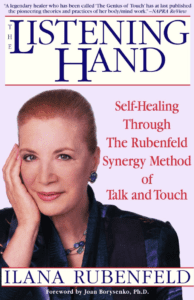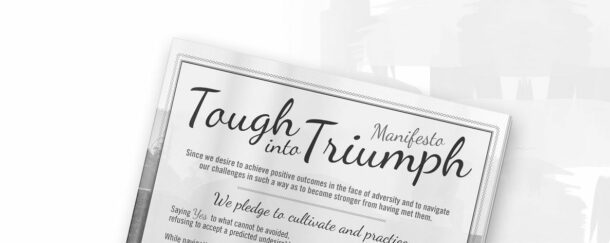
I met Ilana Rubenfeld in Nebraska in 1975 when she was one of the stars of a Human Potential Movement presentation that toured university campuses under the sponsorship of Esalen Institute. The most well-known member of the group of innovators was Warner Erhard, the founder of Est. Alongside of three bragging, chest beating men this lovely petite woman stepped gracefully on to the stage, and captivated her audience, including me. Ilana told a bit of her story, how as a music conductor at Julliard she had suffered with immobilizing back pain that caused her to seek a new profession, one that provided compassionate healing for others suffering as she had with what she considered physical, mental, emotional, and spiritual pain. She had trained in Gestalt Therapy with Fritz and Laura Perls, become a teacher of the F. M. Alexander Technique, and studied with Moshe Feldenkrais, putting together elements from each system. This had led her to declare in the 1960’s that “bodymind” was one word.
After the event organizers had assigned me the job of driving Ilana from Lincoln to the airport in Omaha, I got to visit with her on the over one-hour long drive, telling her how meaningful her presentation was for me, a social work professor, therapist, and former dancer. I’m sure I told her how impressed I was by her onstage demonstration. Using a kind of synergy of gentle touch and soft-spoken conversation sprinkled with humor, the results were an obvious transformation of her volunteer client.
Ilana went on to become the creator of the Rubenfeld Synergy Method, holding her first training sessions in her home in New York in 1997, while continuing her yearly workshops at Esalan in Big Sir CA and Omega Institute in NY state. Somewhere in my study of Gestalt Therapy I came across what we might now call a viral video of her working with Fritz Perls, exhibiting her remarkable sense of humor which I’m sure is what got her through in her relationships with the male dominated field of psychology at the time. When I moved to Texas in 1979, in a chance encounter that only seems to happen in the movies, I ran into Ilana at the DFW airport. She was coming up the escalator as I was going down. It was like no time had gone by and she invited me to participate in her next training session that met once a month for the better part of a year in New York City. After that year, I became part of the training team, and my husband Richard became a student. He had no plans to use her method in his own therapy work, (there was too much risk at that time for a male therapist to touch a woman client) but I encouraged him to take the training, promising him that he would “get his body back,” at the very least, which is what the first year of the work had done for me.
As a social work professor, I felt especially attracted to one section of Ilana’s work–her emphasis on selfcare and her teaching therapists and helpers to take care of themselves while doing their caring work. I brought her to the University of Texas at Arlington where I was co-directing of the Women and Work Research and Resource Center, and she presented at our national conference on Who Helps the Helper? I then suggested we collaborate on a book on that topic. We wrote a proposal to a publisher that she knew, but there was no interest in a book on selfcare. He was interested in a book on her method but neither one of us had the skills at that time to write that book. For over a year we collaborated on the selfcare book as I’d bring the suitcase that contained my luggable computer, (that was what portable meant at that time) and meet her at Esalan. In between sessions where she taught and I assisted, we worked together on the book. Eventually we came to a mutual decision that the material we had was material for two books, mine on selfcare and hers, on the one she felt she needed to write about the Rubenfeld Synergy Method. With the help of a therapist friend, we did the hard work of ended our writing partnership. My book, which used illustrations from her work with her permission came out as Stillpoint: The Dance of Self-Caring, Self-Healing in 1991. Hers titled Listening Hand: Self-Healing Through the Rubenfeld Synergy Method of Talk and Touch was published in 2000 by Bantam Books. My name can be found among the 5 pages of people that she thanked in its acknowledgement pages.
Ilana’s legacy is vast, and by now, the people she has taught have helped people who have helped people, who have helped people. I revised my book since the pandemic, which has been the basis of a weekly online class for professional and family caregivers. Years ago, a woman in Texas that I had introduced to Ilana’s method and training team gave me a Rubenfeld Synergy Session the day after my son died of AIDS on the summer solstice of 1997.
Since I learned of Ilana’s death, I have been grieving gratefully, realizing the impact she has had and continues to have on my life and work. I am transported back to her studio, observing, and recording the artistry that she brought to her helping role. Surrounded by a community of students in training, a client is stretched out on the table. She follows their unburdening with her deep listening hands, supporting their telling of the visceral story their body is revealing. The man has chronic pain in his back, seems he’s had it since the war. With her encouragement he goes a bit further with the “regular war stuff” he started with. His troupes liberated the camps. A Jewish man, he had lost relatives in the camps. Ilana whispers to me, instructions to brush her off as she holds his back, instructions she had received from a Brazilian healer. We stay back, and let the angels help us. She and the man visit his family in happier times, remembering and focusing on how they lived, skiing in the Alps. As they finish and he begins to sit up, he looks like a young child just awakening from a nap.
And then the musician, conductor Ilana, in those days before playlists, cues up and plays a Viennese Waltz. As everyone in the room begins waltzing, and smiling in the knowledge that the atrocities, once stored in the body, are now gone, I remember what Mariam Chase, one of the founders of Dance Therapy taught her students, “Waltzing cures everything.” And I am grateful dear Ilana, that you and I got to dance.
Ilana Rubenfeld AUGUST 20, 1934 – DECEMBER 23, 2022
For more about her method and those currently practicing it https://www.rubenfeldsynergy.com/

